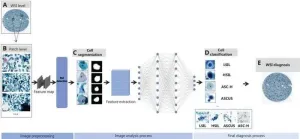(Press-News.org) PHILADELPHIA— Across the United States, no hospital is the same. Equipment, staffing, technical capabilities, and patient populations can all differ. So, while the profiles developed for people with common conditions may seem universal, the reality is that there are nuances that require individual attention, both in the make-up of the patients being seen and the situations of the hospitals providing their care.
New research shows that artificial intelligence can potentially help improve care overall by combing through different hospitals’ data to create more refined groups of patients similar to the local populations that hospitals are actually seeing. AI can help pinpoint typical care needs, such as what specific departments and care teams are required to meet patient needs. Led by researchers at the Perelman School of Medicine at the University of Pennsylvania, the project—whose findings were published in Cell Patterns—analyzed electronic health records of long-COVID patients, revealing a collection of four patient sub-populations—such as those with asthma or mental health conditions—and their specific needs.
“Existing studies pool data from multiple hospitals but fail to consider differences in patient populations, and that limits the ability to apply findings to local decision-making,” said Yong Chen, PhD, a professor of Biostatistics and the senior author of the study. “Our work moves toward providing actionable insights that can be tailored to individual institutions and can further the goal of offering more adaptive, personalized care.”
The study team used a machine learning artificial intelligence technique called “latent transfer learning”, to examine de-identified data on long-COVID patients pulled from eight different pediatric hospitals. Through this, they were able to call out four sub-populations of patients who had pre-existing health conditions. These four included:
Mental health conditions, including anxiety, depression, neurodevelopmental disorders, and attention deficit hyperactivity disorder
Atopic/allergic chronic conditions, such as asthma or allergies
Non-complex chronic conditions, like vision issues or insomnia
Complex chronic conditions, including those with heart or neuromuscular disorders
With those sub-populations identified, the system was also able to track what care patients required across the hospital, pointing toward updated profiles that would allow hospitals to better address increases in different patient types.
“Without identifying these distinct subpopulations, clinicians and hospitals would likely provide a one-size-fits-all approach to follow-up care and treatment,” said the study’s lead author, Qiong Wu, PhD, a former post-doctoral researcher in Chen’s lab who now is an assistant professor of biostatistics at the University of Pittsburgh School of Public Health. “While this unified approach might work for some patients, it may be insufficient for high-risk subgroups that require more specialized care. For example, our study found that patients with complex chronic conditions experience the most significant increases in inpatient and emergency visits.”
The latent transfer learning system directly pulled out the effects these populations had on hospitals, pointing to exactly where resources should be allocated.
If the machine learning system had been in place around March 2020, Wu believes that it might have provided some key insight to mitigate some of the effects of the pandemic, including focusing resources and care on the groups most likely in need.
“This would have allowed each hospital to better anticipate needs for ICU beds, ventilators, or specialized staff—helping to balance resources between COVID-19 care and other essential services,” Wu said. “Furthermore, in the early stages of the pandemic, collaborative learning across hospitals would have been particularly valuable, addressing data scarcity issues while tailoring insights to each hospital’s unique needs.”
Looking past crises such as the COVID-19 pandemic and its aftermath, the AI system developed by Wu, Chen, and their team could help hospitals manage much more common conditions.
“Chronic conditions like diabetes, heart disease, and asthma often exhibit significant variation across hospitals because of the differences in available resources, patient demographics, and regional health burdens,” Wu said.
The researchers believe the system they developed could be implemented at many hospitals and health systems, only requiring “relatively straightforward” data-sharing infrastructure, according to Wu.Even hospitals not able to actively incorporate machine learning could benefit, , through shared information.
“By utilizing the shared findings from network hospitals, it would allow them to gain valuable insights,” Wu said.
This study was supported in part by grants from the National Institutes of Health (U01TR003709, U24MH136069, RF1AG077820, 1R01LM014344, 1R01AG077820, R01LM012607, R01AI130460, R01AG073435, R56AG074604, R01LM013519, R56AG069880, R21AI167418, R21EY034179) and the Patient-Centered Outcomes Research Institute (PCORI) Project Program Awards (ME-2019C3-18315 and ME-2018C3-14899).
END
Using AI to uncover hospital patients’ long COVID care needs
2025-01-10
ELSE PRESS RELEASES FROM THIS DATE:
$1.9M NIH grant will allow researchers to explore how copper kills bacteria
2025-01-10
TUCSON, Arizona — A researcher at the University of Arizona College of Medicine – Tucson received a $1.9 million grant from the National Institutes of Health to continue his research into uncovering the mysteries of copper – specifically, how it can be harnessed to kill harmful bacteria and other microorganisms.
“We started using copper tens of thousands of years ago to cut down on bacterial infections,” said Michael D.L. Johnson, PhD, an associate professor ...
New fossil discovery sheds light on the early evolution of animal nervous systems
2025-01-10
Embargoed until Friday 10-Jan-2025 14:00 ET (10-Jan-2025 19:00 GMT/UTC)
An international team of scientists has uncovered a fascinating piece of the evolutionary puzzle: how the ventral nerve cord, a key component of the central nervous system, evolved in ecdysozoan animals, a group that includes insects, nematodes, and priapulid worms. Their findings, published in Science Advances, provide valuable insights into the origins of these structures in the basal Cambrian period.
The research team, comprising Dr Deng Wang (Northwest University), Dr Jean Vannier (Université ...
A battle of rafts: How molecular dynamics in CAR T cells explain their cancer-killing behavior
2025-01-10
HOUSTON – (Jan. 10, 2025) – A study published in Science Advances shares new insights into how two of the most common types of chimeric antigen receptor (CAR) T cells kill cancer. Investigators from Baylor College of Medicine, Texas Children’s Cancer Center and the Center for Cell and Gene Therapy at Baylor, Houston Methodist Hospital and Texas Children’s Hospital examined how molecular dynamics at the immune synapse – where CAR T cells bind to cancer cells – affect anticancer activity.
In this study, researchers aimed to understand how CAR T cells with different signaling domains work at the molecular and cellular levels to lay the ...
Study shows how plant roots access deeper soils in search of water
2025-01-10
Scientists have discovered how plants adapt their root systems in drought conditions to grow steeper into the soil to access deeper water reserves.
Plant scientists from the University of Nottingham, in collaboration with Shanghai Jiao Tong University, have identified how abscisic acid (ABA), a plant hormone known for its role in drought response, influences root growth angles in cereal crops such as rice and maize. The results have been published in Current Biology.
The study highlights how ABA and auxin, another key hormone, work together to shape root growth ...
Study reveals cost differences between Medicare Advantage and traditional Medicare patients in cancer drugs
2025-01-10
A new study examining the use of high-cost drugs among patients with colorectal cancer and non-small cell lung cancer found those insured through Medicare Advantage received less expensive cancer drugs compared to others on Traditional Medicare.
The findings were published today in JAMA Health Forum.
"Lung cancer is the leading cause of cancer-related deaths in the United States and colorectal cancer ranks third. Gaining a better understanding of treatment options and their costs under different insurance plans is important for assessing the overall healthcare landscape and how insurances manage patient costs,” said the study’s first author Cathy Bradley, PhD, Dean ...
‘What is that?’ UCalgary scientists explain white patch that appears near northern lights
2025-01-10
A whitish, grey patch that sometimes appears in the night sky alongside the northern lights has been explained for the first time by researchers at the University of Calgary.
The article, which was published on Dec. 30 in the journal Nature Communications, explores a “structured continuum emission” that’s associated with aurora borealis.
“You’d see this dynamic green aurora, you’d see some of the red aurora in the background and, all of a sudden, you’d see this structured – almost like a patch – grey-toned or white toned-emission connected to the aurora,” says Dr. Emma Spanswick, ...
How many children use Tik Tok against the rules? Most, study finds
2025-01-10
How many children use Tik Tok against the rules? Most, study finds
As the U.S. Supreme Court considers whether Congress can ban Tik Tok, new research highlights the health risks that top social media platforms pose to children.
Most 11- and 12-year-olds use Tik Tok and other social media despite the platforms’ age restrictions, and many show signs of addiction to social media, a new UC San Francisco study found.
Tik Tok, Instagram, YouTube, and Snapchat require users to be at least 13 years old to have an account. But the study found that a majority of 11- and 12-years olds across the country have accounts on the platforms, ...
Scientists find out why aphasia patients lose the ability to talk about the past and future
2025-01-10
An international team of researchers, including scientists from the HSE Centre for Language and Brain, has identified the causes of impairments in expressing grammatical tense in people with aphasia. They discovered that individuals with speech disorders struggle with both forming the concept of time and selecting the correct verb tense. However, which of these processes proves more challenging depends on the speaker's language. The findings have been published in the journal Aphasiology.
Aphasia is a severe speech disorder, often resulting ...
Tickling the nerves: Why crime content is popular
2025-01-10
Consumers of content about serial killers watch and read it to experience intense emotions that are often lacking in everyday life and to understand the reasons that drive people to commit crimes. However, such content does not contribute to increased aggression. These conclusions were drawn by sociologists from HSE University. The results of their study have been published in Crime, Media, Culture: An International Journal.
Research on the modern media market shows that content about serial killers is popular worldwide, spanning films, true crime series, short videos, and written materials detailing crimes, investigations, ...
Intelligent fight: AI enhances cervical cancer detection
2025-01-10
A cutting-edge article is paving the way for a transformation in cervical cancer screening, leveraging artificial intelligence (AI) to enhance detection accuracy and efficiency. This pioneering research explores the application of AI in medical image interpretation, marking a significant leap in cervical cancer management and prevention. With the aid of deep learning algorithms, the study seeks to address the critical need for more effective screening tests, especially in low- and middle-income countries where traditional methods often fall short. This innovative approach promises to alleviate the global burden of cervical cancer by improving ...



